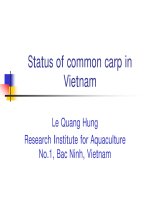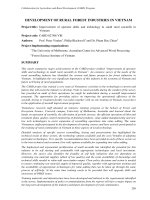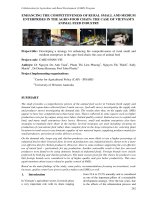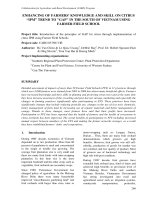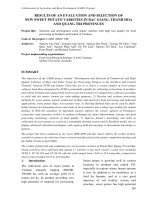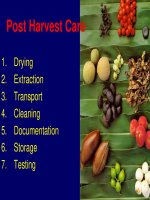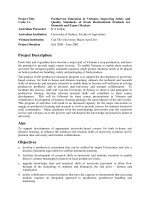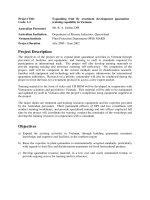Báo cáo nghiên cứu nông nghiệp " Extension of citrus IPM in Vietnam " pptx
Bạn đang xem bản rút gọn của tài liệu. Xem và tải ngay bản đầy đủ của tài liệu tại đây (105.37 KB, 17 trang )
Project Title
Code: 2.2
Extension of citrus IPM in Vietnam
Australian Personnel
Professor GAC Beattie, Dr Debbie Rae
Australian Institution
Centre for Horticulture and Plant Sciences, University of
Western Sydney
Vietnam Institution
National Institute of Plant Protection
Plant Protection Department, MARD
Project Duration
July 2001 to December 2003
Project Description
The aim of the proposed activity is to enhance Viet Nam’s capacity for teaching and
research and development in the citrus sub-sector of agriculture. This will be achieved by
the publication of reference texts and the development of high quality curricula for
farmer field schools (FFS) in citrus IPM. The three Vietnamese texts will incorporate the
research results of ACIAR project CS2/96/176, current information not easily accessed in
Viet Nam and new information collected from throughout Viet Nam as part of the
activity. Training activities will include an intensive course for 21 key Vietnamese
personnel in Australia, and local workshops for 90 Plant Protection Sub-Department staff
and 120 IPM trainers, technical resource people and farmers. FFS curricula will be
developed from experiments conducted over two full growing seasons in two key citrus
growing locations.
Objectives
(a) Produce a pictorially based booklet in Vietnamese on spray application and use of
PSOs, for use by citrus farmers.
(b) Produce a more technical booklet in Vietnamese on spray application and use of
PSOs, for use by technicians and scientists
(c) Produce a reference book in Vietnamese on citrus pests and natural enemies in
Viet Nam. This would be modelled on “Citrus pests and their natural enemies:
Integrated pest management in Australia” although smaller in scope. For each of
the major pests there will be a high quality colour photograph, photographs of
natural enemies, a map showing distribution and severity of the pest throughout
Viet Nam and written information. The text would include a description of the
pest, the damage caused, natural enemies and management of the pest. Plant
Protection Sub-Department information on citrus pests is currently available
province by province from the Community IPM Fruit IPM Baseline Survey
database, and would be contributed to this activity proposal. However, natural
enemy data is not readily available and would require collection and rearing by
PPSD personnel and identification by NIPP.
(d) Train key Vietnamese extension scientists and technicians at UWS in aspects of
PSO use in IPM programs relevant to the citrus industry. Key scientists will be
chosen from a range of institutions (Appendix 2), taking their level of
involvement in the proposed activity (Appendix 3) gender issues and English
skills into consideration.
(e) Undertake season long field studies and pilot FFS for two consecutive seasons at
two important citrus growing locations in Viet Nam to develop curricula for
Training of Trainers (TOT) and FFS. Exact locations would be chosen during the
course of the proposed activity, but would be within two of the four top citrus
growing provinces of Can Tho, Ha Nam, Son La and Quang Nam.
Outputs and Performance indicators
1. Publication of the booklet on spray application and use of PSOs, for use by citrus
farmers.
2. Publication of the technical booklet on spray application and use of PSOs, for use
by technicians and scientists
3. Publication of the reference book on citrus pests and natural enemies in Vietnam.
4. Participation of key Vietnamese extension scientists and technicians in intensive
training in Australia.
5. Completion of season long field studies and pilot FFS for two consecutive seasons
at two important citrus growing locations in Viet Nam and development of
curricula for TOT and FFS
COMPLETE REPORT
Executive Summary
Adoption of integrated pest management leads to both economic and environmental
benefits. Higher profits can be achieved through reductions in inputs and associated costs
and the use of more sustainable farming practices. However, as IPM uses a wide range of
different but complimentary methods to reduce pest populations, it requires greater
knowledge to implement than pest control based on the use of high inputs of broad-
spectrum synthetic agrochemicals. The most successful method of providing this
knowledge and implementing IPM in less developed countries has been through the use
of Field Farmer Schools (FFSs). FFSs empower farmers to learn and create a better
situation for themselves, rather than passively relying on others to make decisions for
them. Viet Nam has a well-developed National IPM program and an excellent extension
capability based on the FFS model. However, prior to this project Viet Nam lacked
resource materials and specific expertise in citrus IPM extension. This project has
addressed these deficiencies by developing high quality curricula for FFSs in citrus
through field activities conducted over 2 seasons involving 60 citrus growers from 2
villages in Nghe An province and 47 growers from Tien Giang province. The project also
produced two reference texts in Vietnamese. A third planned reference was not
completed as originally envisioned due to a range of factors, the most critical of which
was the declining health of a key Vietnamese scientist from the National Institute for
Plant Protection (NIPP). However, the text of a book has been produced by Plant
Protection Department and Can Tho University personnel and is ready for publication.
The only requirement to achieve this is approval to use remaining project funds held at
NIPP and UWS for publication by the Agricultural Publishing House. In order to fully
realise the benefits of this project, it is strongly recommended that further support be
provided to allow Training of Trainers (TOT) for about 30 Master Trainers in citrus IPM
masters in the near future. Support to allow the adoption of a media approach to motivate
farmers to become involved in citrus IPM FFSs using the approach of the recent award
winning “Three-Reductions Initiative” in rice would also be highly beneficial.
1.0 Project Description
1.1 Background and preparation
The stated aim of the project was to enhance Viet Nam’s capacity for teaching and
research and development in the citrus sub-sector of agriculture. This was to be achieved
through publication of reference texts and the development of high quality curricula for
farmer field schools (FFS) in citrus IPM. The three Vietnamese texts were to incorporate
the research results of Australian Centre for International Agricultural Research (ACIAR)
project CS2/96/176, current information not easily accessed in Viet Nam and new
information collected from throughout Viet Nam as part of the activity. Training
activities were to include an intensive course for key Vietnamese personnel in Australia,
and local workshops for Plant Protection Sub-Department staff and integrated pest
management (IPM) trainers, technical resource people and farmers. FFS curricula were to
be developed from experiments conducted over two full growing seasons in two key
citrus growing locations.
1.2 Context and rationale
The project stemmed from two ACIAR projects ‘Integrated Control of Citrus Pests in
China’ (ACIAR CS2 1993 005; 1993-1997) and ‘Integrated Control of Citrus Pests in
China and Southeast Asia’ (ACIAR CS2 1996 176; 1997-2000). It was undertaken in
collaboration with personnel from the lead partner institutions in Viet Nam, the National
Institution for Plant Protection (Ministry of Agriculture & Rural Development: MARD)
and the Plant Protection Department (MARD). A collaborative research relationship was
established with the National Institution for Plant Protection in 1997 as part of ACIAR
project CS2 1996 176. During that ACIAR project Centre for Horticulture and Plant
Sciences (CHAPS) personnel made contact with Plant Protection Department staff,
through FAO personnel and the Viet Nam National IPM Programme. The current project
marked the commencement of a collaborative working relationship between CHAPS and
the Plant Protection Department.
Other institutions involved in the current project included:
Southern Fruit Research Institute (MARD),
Research Institute of Fruits and Vegetables (MARD),
Agricultural Extension Department (MARD), and
Can Tho University,
Farmers were identified as the key beneficiaries of the project.
The project was developed and conducted on the premise that adoption of IPM-based
technology previously developed in Southeast Asia would lead to significant reductions
in the use of broad-spectrum synthetic pesticides in Vietnamese citriculture, and that such
reductions in pesticide use would result in benefits to the environment, the health of farm
workers who apply agricultural chemicals, and the health of consumers who eat citrus
fruit.
During ACIAR CS2 1996 176 links were established between CHAPS personnel and the
FAO Programme for Community IPM in Asia. The then Vietnam Country Programme
Officer, Dr Patricia Matteson was very interested in the results of the project. Copies of
all ACIAR research reports were sent to the FAO Programme for Community IPM office
in Hanoi, and Dr Matteson was invited to two project workshops in Hanoi. The reviewers
of the project made two recommendations in relation to Viet Nam, the most important of
which stated ‘ACIAR should discuss extension prospects within Viet Nam with the PPD,
AusAID, FAO and other relevant agencies mentioned in this report. The aim should be to
establish a system of Training of Trainers and Farmer Field Schools as widely as possible
through citrus growing areas of Viet Nam’. This recommendation was based on the then
current lack of:
• Vietnamese texts on citrus pests, natural enemies, spray application and technical
aspects of spray oils, and
• FFS curricula and training in citrus IPM required to commence the process of
dissemination of results to the end users, the citrus farmers.
Viet Nam has demonstrated an excellent extension capability based on the FFS model,
which has been managed by the National IPM program. FFSs have trained more than
500,000 farmers to make better decisions about growing healthy crops in ways that are
both sustainable and profitable. Special emphasis is given to providing the farmers with
alternative tools for pest control to allow their dependence on chemical pesticides to be
reduced. Most FFS have been on rice, but curricula have also been developed, and FFS
facilitated for, vegetables, tea, cotton, soybeans, and peanuts. However, until recently
production of citrus has been assigned a much lower priority than that of rice and other
staple crops. Consequently, development of a FSS program for citrus in Viet Nam lacked
resource materials and specific expertise in citrus IPM extension. The objectives of this
AusAID CARD project ‘Extension of Citrus IPM in Viet Nam’ addresses these needs.
The project was undertaken concurrently with preparation for, and the first year of,
ACIAR CS2 2000 043 ‘Huanglongbing management for Indonesia, Vietnam and
Australia’, a Horticulture Australia Limited project ‘Incursion management for
huanglongbing (citrus greening) and its vector (Asiatic citrus psyllid)’ (HAL CT 2002
005), and support for extension activities linked to the marketing of horticultural and
agricultural mineral oils in Asia.
1.3 Project objectives and scope at design
The aim of the project was to enhance Viet Nam’s capacity for teaching and research and
development in the citrus sub-sector of agriculture. The project design was relevant to
both the AusAID country strategy and the Vietnamese government program, as sound
education and information about technical subjects always promote progress.
The proposed activities were designed to achieve capacity enhancement through:
• the provision of essential resource material and training of key Vietnamese
personnel in Australia, and
• the development of curricula for TOT and FFS, which were not available in Viet
Nam at the inception of the project.
The major development objectives were:
I. Produce a pictorially based booklet in Vietnamese on spray application and use of
PSOs, for use by citrus farmers.
II. Produce a more technical booklet in Vietnamese on spray application and use of
PSOs, for use by technicians and scientists
III.Produce a reference book in Vietnamese on citrus pests and natural enemies in Viet
Nam modelled on ‘Citrus pests and their natural enemies: Integrated pest management
in Australia’ but smaller in scope. The book was to include high quality colour
photographs of pests and natural enemies, a map showing distribution and severity of
the pest throughout Viet Nam, and written information describing the pest, the damage
caused, and its natural enemies and management. Existing provincial Plant Protection
Sub-Department information on citrus pests from Community IPM Fruit IPM Baseline
Survey database was to be used for the book but collection of natural enemy data,
which was not readily available before the project, was to be collected by PPSD and
NIPP personnel.
IV.Train key Vietnamese extension scientists and technicians at UWS in aspects of PSO
use in IPM programs relevant to the citrus industry. Key scientists were to be chosen
from a range of institutions based on their level of involvement in the proposed
activities, gender issues and English skills.
V. Undertake season long field studies and pilot FFS for two consecutive seasons at two
important citrus growing locations in Viet Nam to develop curricula for Training of
Trainers (TOT) and FFS.
1.4 Implementation arrangements
Institutional arrangements outlined in the project document were that CHAPS personnel
would assist with the preparation of material to be included in the proposed publications,
oversee the publication process and arrange for training of key Vietnamese scientists in
aspects of IPM relevant to citrus in Australia. NIPP were to oversee the adaptation of
material to be included in the publications, for the local situation. They were also to
oversee the collection of specimens (for photographs) and information about citrus pests
and natural enemies from throughout Viet Nam, and be responsible for all translations.
PPSD personnel were to collect natural enemies and relevant information from
throughout Viet Nam and provide these specimens and information to NIPP. The PPD
National IPM programme were to oversee the season long field studies, pilot FFSs and
development of curricula. NIPP and PPD were to jointly organise the workshops. All
implementation arrangements were carried out as outlined in the project document.
2.0 Appropriateness of Project Design and Objectives
2.1 Appropriateness of Objectives
Objective
No.
Objective Description Appropriateness
rating
I
Produce a pictorially based booklet in Vietnamese on
spray application and use of PSOs, for use by citrus
farmers
5
II
Produce a more technical booklet in Vietnamese on
spray application and use of PSOs, for use by
technicians and scientists
5
III
Produce a reference book in Vietnamese on citrus pests
and natural enemies in Viet Nam containing high
quality colour photograph of each pest, photographs of
natural enemies, a map showing distribution and
severity of the pest throughout Viet Nam. Text was to
include a description of each pest, the damage caused,
and its natural enemies and management.
5
IV
Train key Vietnamese extension scientists and
technicians at UWS in aspects of PSO use in IPM
programs relevant to the citrus industry.
5
V
Undertake season long field studies and pilot FFS for
two consecutive seasons at two important citrus
growing locations in Viet Nam to develop curricula for
Training of Trainers (TOT) and FFS.
5
Rating. 5: Best practice; 4: Fully Satisfactory; 3: Satisfactory Overall; 2: Marginally
Satisfactory; 1: Weak
2.2 Appropriateness of Design
Within the 5 objectives there were 2 key project design features. These were the
production of reference texts and development of high quality curricula for farmer field
schools (FFS) in citrus IPM through training and experience gained in both Australia and
Viet Nam. The production of reference texts to provide information on biological control,
integrated pest management and other alternative methods of pest control was deemed as
a highly appropriate approach to address the problem of pesticide overuse in citriculture
in Viet Nam. Previous experience with the FFS model in Viet Nam had demonstrated that
the model is a highly effective and appropriate method of empowering farmers with the
tools to make informed decisions about how to grow their crops and manage pests and
diseases in a sustainable way. Rapid advances achieved in sustainable rice farming over
the past decade allowed Viet Nam to transform from a rice importer to the world’s third
largest rice exporter. Similar achievements can be expected in fruit crops including citrus
in the future, if effective extension of information to farmers is accomplished.
Description of design features Appropriateness rating
Production of 3 reference texts 5
Development of high quality curricula for farmer field schools
(FFS) in citrus IPM
5
Rating. 5: Best practice; 4: Fully Satisfactory; 3: Satisfactory Overall; 2: Marginally
Satisfactory; 1: Weak
3.0 Implementation Performance
3.1 Project Components and Outputs
Objectives I, II, IV and V were all successfully completed within the approved extension
of the project. Objective III was not completed but actions required to complete this
objective using residual funds is outlined below.
Component
No.
Component Description Outputs Performanc
e Indicators
Performance
Rating
I
Produce a pictorially
based booklet in
Vietnamese on spray
application and use of
PSOs, for use by citrus
farmers
2,000 copies of
book printed
and distributed
Publication
of book
completed
3 (completed)
II
Produce a more technical
booklet in Vietnamese on
spray application and use
of PSOs, for use by
technicians and scientists
1,000 copies of
book printed
and distributed
Publication
of book
completed
3 (completed)
III
Produce a reference book
in Vietnamese on citrus
pests and natural enemies
in Viet Nam containing
high quality colour
photograph of each pest,
photographs of natural
enemies, a map showing
distribution and severity
of the pest throughout
Viet Nam. Text was to
include a description of
each pest, the damage
caused, and its natural
enemies and
management.
Originally
envisaged book
not completed
but an
alternative book
containing 3
major sections
on: cultural
techniques;
pests and
diseases of
citrus; and plant
protection has
been written
and is ready for
publication.
Publication
of book
possible
depending
on approval
to use
remaining
funds from
UWS and
NIPP.
2 (pending)
IV
Train key Vietnamese
extension scientists and
technicians at UWS in
aspects of PSO use in
IPM programs relevant to
the citrus industry.
Intensive
training of 21
key Vietnamese
personnel in
Australia
Attendance
at lectures
and field
visits and
participation
in practical
sessions.
4 (completed)
V
Undertake season long
field studies and pilot
FFS for two consecutive
seasons in Nghe An and
Tien Giang provinces to
develop
> 130 farmers
and > 16
trainers
participated in
FFS activities
Production
of farmer
training
guides and
technical
information
4 (completed)
5: Exceeding time and quality targets, 4: Achieving time and quality targets and on
budget; 3: Moderate progress towards targets, some issues about quality, budgets or costs
but these are being adequately addressed; 2: Some progress towards targets, but slippage
in schedule and cost overruns; & 1: Significant problems in achieving targets, quality
outputs unlikely to be achieved and substantial cost increases affecting overall budget.
Objectives I, II, IV and V were all successfully completed within the approved extension
of the project. Objectives IV and V were achieved on time and within budget. Training
was a very important component of the project, and in addition Objective IV allowed the
establishment of an excellent rapport between key Vietnamese scientists and Australian
project personnel. Season long field studies conducted under Objective V resulted in the
production of farmer training guides and technical information for trainers in each of the
participating provinces (Annexes 1-5).
Objectives I and II were achieved with some slippage in relation to the original schedule
and slight overruns in the budget. However, there was considerable expansion in the
scope of the 2 books published in relation to that originally envisaged in the project
document. Book 1 was planned to be a 30 page black and white booklet, but was
published as a 62-page booklet on high quality paper including 18 pages with colour
plates (Annex 6). The increases in cost were partially compensated for by decreasing the
print run from 5,000 to 2,000 but the overall cost was still higher than provided for in the
budget. The second book was planned to be a 50 page black and white booklet but the
published book has 136 pages (Annex 7). The print run was not reduced from the
originally planned 1,000 copies. Distribution of the first book was previously reported
(Annex 8) and distribution of the second book used the same distribution list with
numbers halved to each institution.
Objective III was not fully completed due to a range of factors, the most critical of which
was the ill health of Prof Nguyen Van Cam. According to the project document, 7
Vietnamese personnel were scheduled to be involved in the production of Book 3, with
Dr Pham Van Lam and Prof. Nguyen Van Cam from NIPP being most involved. Over the
course of the project Dr Pham Van Lam became more involved in political activities and
was required to attend an extensive course to this regard. Prof. Nguyen Van Cam was the
driving force in relation to the first 2 publications, but declining health during this time
resulted in slippage in the schedule. In January 2004 Prof. Nguyen Van Cam contacted
Prof. Andrew Beattie to formally acknowledge his inability to be involved in cooperative
research projects (Annex 9). Both the activity director from the Plant Protection
Department, Mr Nguyen Huu Huan and Mr Huynh Tri Duc completely fulfilled their
commitment to Objective III by each writing a book chapter. In addition 2 researchers
from Can Tho University have contributed chapters to the book, as well as Mr Ho Van
Chien, Director of the Southern Regional Plant Protection Centre and one of the
participants in Objective IV. This book entitled “QUAN LY SINH THAI VUON CAY
CO MUI” (Ecological management of citrus) is now ready for publication and a mock
copy is provided in Annex 10. NIPP only have 45,000,000 VND (~$A 3,700) remaining
in their budget, which is not sufficient to produce this publication ($A9,580 was
originally budgeted in the project document to produce 1,000 copies). However, UWS
have $20,581 residual funds as a result of savings made on airfares and other travel costs
associated with 21 Vietnamese personnel visiting Australia for intensive training in the
first year of the project. It is therefore proposed that AusAID give approval for these
residual funds to be used for publication. Current estimates of publication costs for a
range of publication runs are provided in the table below. Funds could be allocated in a
number of ways depending on the advice of AusAID, however, our suggested option
would be 6,000 copies of book 3, 3,000 additional copies of book 1 and 2,000 additional
copies of book 2. The cost of this would be around $23,430 for publishing plus some
minor costs for final technical editing.
Publication No. copies Cost ($AUD)
Book 3 2,000 6,227
5,000 12,140
10,000 21,555
Book 1 2,000 4,129
3,000 6,194
Book 2 1,000 991
2,000 1,982
The only approved change to the project was a 6 month extension without any additional
funds, to allow field experiments to be conducted over 2 complete citrus growing
seasons. This change was critical to the success of the project and highlights the
importance of considering agricultural and environmental time frames when designing
capacity enhancement projects for rural development.
A major factor that influenced the project in both positive and negative ways was that the
project was driven from within Viet Nam by individuals who had a good raporte with
Australian project personnel and also shared a similar scientific paradime, rather than
through the institutions that we dealt with. This was very positive in terms of the
excellent working relationship that was developed with a range of Vietnamese
personnnel, particularly PPD staff and Can Tho University personnel that were not
known to the Australian project personnel prior to the commencement of this project. In
relation to PPD personnel, the excellent relationship that was developed between the
Vietnamese Activity Director Mr Nguyen Huu Huan, and one of his senior staff, the
Director of the Southern Regional Plant Protection Centre, Mr Ho Van Chien and their
direct involvement in the activities of the project spilled over to many other PPD staff.
However, in relation to NIPP the excellent working relationship that we had with
Professor Nguyen Van Cam, which had developed in a previous ACIAR project, had a
negative influence on the project in the particular circumstances encountered. Although
the nominated Activity Director for NIPP was Dr Nguyen Van Tuat, he was very heavily
committed in other activities and was not directly involved in the project. Professor
Nguyen Van Cam was the driving force in relation to the project within NIPP, but
unfortunately his health began to deteriorate not long after the commencement of the
project. Initially it resulted in minor slippage in the project, but this began to increase
over time. Because of our great respect for Professor Nguyen Van Cam we did not feel it
appropriate for us to comment directly to him in relation to his illness, and unfortunately
it appears that he was not given support from within his Institute to assist with the project
activities by allocating other staff to assist him. Professor Nguyen Van Cam did directly
inform Professor Andrew Beattie of his failing health, but this was not until after the
completion of the current project. So in this case the project being driven by an individual
rather than the collaborating institution resulted in some negative effects through lack of
general support from the institution.
3.2 Project Outcomes
There were 4 key outcomes
• publication of two books in Vietnamese
• training of farmer field school trainers, and
• inagural farmer field schools for citrus farmers.
The first book, ‘A Guide for Using Mineral Oils in Vietnamese Citrus IPDM’ was the
first book of this type to be published in Viet Nam and there is interest in having the
original English text translated and modified to account for the regional incidence and
importance of pests in China, Thailand and Malaysia. Although 2000 copies of this book
were distributed in Viet Nam, it appears that awareness of the book remains low, and a
number of project personnel from Tien Giang Province had not seen the book even
though it was sent to the directors or heads of their work units. Clearly more copies of the
text are needed and efforts made to distribute the books more directly to both extension
workers and farmers. This could possibly be achieved by working together with oil
distributors to provide the books to extension workers recommending use of oil and
farmers that purchase spray oil. Appraisal of the book by Vietnamese farmers and farmer
field trainers was not within the scope of the present project, but this would be a valuable
exercise that would provide very useful information. After such appraisal it is highly
recommended that necessary minor changes be made to the text and a second edition of
the book be published in larger numbers.
The second book ‘Use of Horticultural and Agricultural Mineral Oils in Citrus IPDM’ is
also the first such publication in Vietnamese and is novel in that it is the first text to
comprehensively deal with the use of mineral oils to control phytophagous pests of citrus
in Asia. The targeted audience of this more technical publication is extension workers,
IPM trainers and scientists. Like with the first book it would also be a very valuable
exercise to seek appraisal of the text by the targeted audience, and to assess whether
sufficient copies have been published.
Season long field studies and pilot FFSs were very effectively conducted at 2 locations in
Viet Nam. In Nghe An province a total of 6 FFSs involving 180 farmers were conducted
and 8 technicians developed their skills to a level where they can hold “Training of
Trainers” schools (TOT). In Tien Giang province a total of 53 farmers from 3 village
groups received awards for participation in the program. At this site there were also 6
FFSs involving 8 trainers. FFSs and training activities resulted in the development of
farmer training manuals and technical reports on studies conducted in both Nghe An and
Tien Giang province sites (Annexes 1-5). Differences between locations were actively
discussed at the final workshop held from 16-17th December 2003.
As was outlined in the project document, full utilisation of the citrus IPM curriculum
developed as part of this project will require further support from donor agencies in the
initial period until local funding can be attracted. Ideally an initial TOT for about 30
Master Trainers in citrus IPM should be conducted in the near future. These master
trainers would then facilitate FFS in high priority provinces. In other crops local funding
for FFS often comes from combined sources including local government, Women's
Union, Farmer Union, NGOs, other donor-funded projects, cooperatives and the fruit
farmers themselves. Long-term sustainability comes from local demand plus willingness
to provide financial support in order to meet local agricultural development needs.
Farmers involved in this project to date have shown very high levels of interest, which
would increase the likelihood of long-term sustainability.
An additional unscheduled activity conducted by Southern Regional Plant Protection
Centre personnel, particularly Mr Ho Van Chien and Can Tho University personnel,
particularly Dr Tran Van Hai was the production of interactive CDs containing a range of
information and pictures relating to the ecological management of citrus. Additional
training in the professional production of interactive CDs would be extremely beneficial
for the involved personnel and the provincial trainers who are the major target audience
for these CDs.
The PPD Activity Director, Mr Nguyen Huu Huan was recently involved in a “Three-
Reductions Initiative” that won the MARD 2003 Golden Rice Award, for best
agricultural innovation (Annex 11). The initiative used radio and TV broadcasts,
supplemented by farmer interviews and game shows to reach 90% of targeted farmers
with information that motivated them to experiment with reducing seed rates, fertilizer
and pesticides. Many farmers discovered they could greatly reduce input costs and
government agencies and funding organisations were motivated to allocate additional
resources to extend the three-reductions practices. The adoption of such an initiative in
relation to citrus IPM would greatly improve future performance of the FFSs developed
for citrus in this project.
3.3 Sectoral Impact
This project has led to the development of the tools required to allow citrus farming
communities and women within those communities be empowered to learn about
different citriculture and plant protection methods and make informed decisions about
methods that suit them best, rather than passively relying on others to make decisions for
them. More than 130 farmers were involved in the pilot FFSs with more than 50% of
those farmers in Nghe An province being women. In addition 3 of the 8 trainers involved
in the project in Nghe An province were women. In Tien Giang province the level of
participation of women was very low with only one woman farmer and no women
trainers. This issue was raised with project personnel. The National director of the IPM
program, Mr Ngo Tien Dung informed us that gender studies conducted by FAO in other
crops have shown that the participation rates of women in IPM is higher in northern
regions of Viet Nam at 40 to 70% compared to 10 to 30% in southern regions. Despite
this lower level of participation as a result of cultural differences in southern Vietnam,
Mr Ngo Tien Dung believes that women still want to learn. Although a range of factors
are involved in determining the level of participation of women in FFS activities, one of
the most important is the process of selection of participants. In future activities it has
been suggested that a closer association be developed with the local Women’s
Association and training activities be organised with them. The facilitation skills of
trainers also need to be strengthened and gender exercises introduced to the training
program in regions where the level of participation of women is lower.
3.4 Costs and Financing
Cost estimates made during the design of the project were reasonably accurate in relation
to actual costs incurred (Appendix A1.0). Althought there was some variation in line
items of the budget, partly being due to different categories being used by the funding
agency and the accounting system of the lead Australian institution, the overall budgeting
was excellent. In the first tranche, a large part of the budget was allocated for
international travel when 21 Vietnamese scientists attended intensive training in
Australia. Savings were made in relation to this travel, mainly through an 18% lower cost
in airfares and lower insurance costs than budgeted. These savings were carried over to
the second tranche, but were not spent. In the second tranche 100% of funds were
accquitted. Some savings were made in relation to travel as economy air fares were
budgeted, but special fares were purchased, and these compensated for increases in all
salary costs due to University salary increases
3.5 Monitoring of project
Monitoring arrangements outlined in the project document were:
i. Publications: NIPP and CHAPS personnel would jointly report progress in six-
monthly reports, which would be compiled by CHAPS.
ii. Workshops in Vietnam: Key Vietnamese personnel would monitor the effectiveness
of workshops by asking a sample of participants a series of set questions and
recording the answers.
iii. Training in Australia: The level of understanding and appropriateness of material
would be monitored throughout the intensive training course using a series of
informal quizzes. At the end of the training, participants would be asked to complete
an anonymous questionnaire and findings reported in the first six-monthly report.
iv. Development of FFS curricula: PPD personnel would report progress every three
months and CHAPS personnel would visit study sites every six months. Findings
would be incorporated into six-monthly reports.
v. Acquittal of AusAID funding and tracking of institutional contributions: The
Research Office of UWS would manage all activity funds and arrange a written
agreement with all recipient parties to specify accounting/ acquittal procedures.
CHAPS, NIPP and PPD will each be individually responsible for providing six-
monthly acquittals to the Research Office to incorporate into the annual financial
reports.
All of these monitoring arrangements were conducted as envisioned. In relation to (ii),
effectiveness of workshops was determined both informally and with written surveys. All
information was collected in Vietnamese in relation to this monitoring, and given the
additional time and resources required to translate it to English, this was not requested by
the Lead Australian Institution. However, results were discussed between Vietnamese
partner institution personnel. Findings were in agreement with the observations of the
Lead Australian Institution personnel, that the workshops were highly effective and
appropriate.
All monitoring methods were effective, as problems were identified during the course of
the project. However, being aware of problems does not necessarily enable those
problems to be dealt with, particularly in the case of sensitive issues like ill health.
3.6 Technical Assistance, Training and Capacity Building
The outcomes from this project have enormous potential to assist with capacity building
in the citrus sub-sector of agriculture. Citrus is grown throughout Viet Nam and there are
more than 340,000 households currently involved in citrus farming. This is expected to
increase quickly because of government initiatives to encourage farmers to diversify from
rice growing into fruit crops. However, in order to grow citrus in an ecologically
sustainable way, farmers need knowledge and experience. The training programs
undertaken in this project and the FFS curricular produced, provide the framework
through which farmers can gain the required knowledge and experience. However, only
the farmers and trainers directly involved with the pilot FFS activities have been able to
benefit to date. Other farmers will not be able to benefit until the training program is fully
implemented. Full implementation requires an initial TOT for about 30 Master Trainers,
who then facilitate FFS in high priority provinces. The TOT for Master Trainers will
require support from donor agencies.
3.7 Management of Constraints, Issues, Risks and Change
The major difficulty encountered in this project was slow but progressive slippage in the
progress of producing publications. The reasons for this slippage have been discussed at
length in section 3.1 of this document. However, the slippage did not impact on the
achievement of the publication of two booklets and had little effect on the overall budget.
A recommended approach to the management of these difficulties has been presented in
section 3.1 (pages 7 and 8).
3.8 Project Management
Ideally the performance of the Lead Institution over the life of the project should be
judged by an independent reviewer as occurred in previous ACIAR projects. Personnel
from the Lead Australian Institution maintained communication with Vietnamese project
personnel throughout the project and they carried out all activities as outlined in the
project document. The excellent rapport developed between Australian and Vietnamese
personnel over the course of the project and the extremely high level of respect shown by
the Vietnamese provides strong evidence that they were happy with the performance of
the Lead Australian Institution. A rating of 4 is given for the Lead Institution.
In relation to NIPP there was some slippage in this schedule and, as noted above and in
previous reports, this was mainly due to the deteriorating health of one of the key
Vietnamese collaborators, Prof Nguyen Van Cam. There was some slippage in the budget
but this was due to an expansion in the scope of Objectives I and II. The additional effort
put into these publications is to be highly commended. A rating of 3 is given.
Key PPD staff were very devoted to the cause of educating their trainers and farmers and
devoted a considerable amount of time working directly with them. We were very
impressed with the PPD training program and the skills they have developed in the course
of leading FFSs in rice and other crops. PPD staff also had an excellent working
relationship with Can Tho University personnel, who also contributed greatly to the
project. At the outset of the project the Lead Australian Institution had no contacts with
Can Tho University and did not envision their involvement in the project. However, as a
result of this project UWS is working towards signing a memorandum of understanding
that would lead to the development of joint postgraduate degrees between UWS and Can
Tho University. An overall rating of 5 is given to the PPD.
4.0 Performance and Outcomes
4.1 Assessment of Performance Aganist Objectives and Design
The expected outcomes of the project are outlined in Section 3.1 of this document. Of the
five expected outcomes, two books were published (Annexes 6 and 7), intensive training
of 21 key Vietnamese scientists was conducted in Australia, and season long field studies
and pilot FFSs were conducted at study locations in Nghe An and Tien Giang provinces.
The FFSs and experiments led to the development of farmer training manuals and
technical information for trainers (Annexes 1-5). The only objective that was not
achieved was the publication of the third book, but the book has been prepared to mock
up stage for publication (Annex 10) and actions required to complete this objective using
residual funds is outlined in section 3.1 of this document. Whether the publication will be
completed or not and the timing of completion depends on the decision of the funding
organisation to accept the recommended action.
The full impact of the outcomes from this project will take time to be realised, and will
require additional support from donor agencies in order to carry out TOT as discussed in
sections 3.2 and 3.6 of this document. The time to reach full implementation of FFS for
IPM in citrus will depend on when funds can be obtained to carry out initial TOT for 30
Master Trainers, and how long after the training is completed until FFSs are initiated in
high priority provinces.
4.2 Sustainability
This project has a high level of financial sustainability. No further inputs are required for
the two published texts until the information becomes out of date. However, it has been
identified that a year after publication awareness of the first book remains low indicating
the need for additional copies to be printed and more direct distribution methods adopted.
However, the cost of producing second editions is much lower than initial costs.
The development of a high quality IPM curriculum for citrus farmers is also highly
sustainable. The materials developed are suitable for use in FFSs throughout Vietnam,
with only minor regional modifications, and there will also be no recurrent costs to be
borne by the PPD National IPM Program. However, in order to expand the training of
citrus farmers beyond the scope of this project, financial support will be necessary. This
is to Experience from FFSs in other crops has shown that local interest often results in
local funding from a range of sources including local government, Women's Union,
Farmer Union, NGOs, other donor-funded projects, cooperatives and the fruit farmers
themselves. Long-term sustainability comes from local demand plus willingness to
provide financial support in order to meet local agricultural development needs.
Control of citrus pests and diseases in Vietnam is currently based almost exclusively on
the use of broad-spectrum synthetic pesticides. Farmers often depend heavily on pesticide
sales representatives for advice as to what pest or disease problems they have and what to
do about them. Simply being able to recognise what pests they have and understanding
the seriousness of those pests will allow them to make more informed decisions about
pest control. Being able to distinguish a pest from a natural enemy and having some basic
understanding of the relationship between pests and natural enemies will help them to
understand field ecology better, and allow them to reduce pesticide use. The replacement
of broad-spectrum synthetic pesticides with more IPM compatible chemicals such as
petroleum derived spray oils will result in benefits to the environment, the health of farm
workers who apply agricultural chemicals, and the health of consumers who eat citrus
fruit.
An overall rating of 4 is given for the sustainability of this project.
4.3 Development Impact
The potential development impact of this project is large and the Vietnamese perspective
has been discussed by Mr Ho Van Chien in his final report for the project (Annex 12).
Since the initial implementation of FFSs in Viet Nam more than 500,000 farmers have
been trained to make better decisions about growing healthy crops both sustainably and
profitably. Within the FFS curriculum, special emphasis is given to reducing dependency
and usage of chemical pesticides. Most FFS have been on rice, but curricula have also
been developed, and FFS facilitated for, vegetables, tea, cotton, soybeans, and peanuts.
The development of curricular for IPM in citrus has the potential to reach farmers within
the 340,000 households currently involved in citrus farming. This is the first time that a
FFS curricular has been developed for a tree crop and it will open the way for future
FFSs to be developed in other fruit crops such as mango, litchi and longan.
5.0 Conclusions
5.1 Overall assessment
This project has achieved the publication of ‘A Guide for Using Mineral Oils in
Vietnamese Citrus IPDM’ and ‘Use of Horticultural and Agricultural Mineral Oils in
Citrus IPDM’. These two books are the first of their type to be published in Vietnamese
thus allowing scientists, trainers, extension workers and farmers access to information
previously not available in their own language. A third text “Ecological Management of
Citrus” is ready for publication and only requires approval to utilise unspent project funds
for this purpose.
Season long field studies and pilot FFSs conducted at 2 locations in Viet Nam have led to
the development of the tools required to allow citrus farmers to be empowered to learn
about different citriculture and plant protection methods and make informed decisions
about methods that suit them best. This has been achieved through FFSs and training
activities that resulted in the development of farmer training manuals and technical
reports on studies conducted in both Nghe An and Tien Giang province sites. Full
utilisation of this citrus IPM curriculum will require further support from donor agencies
in the initial period until local funding can be attracted. Ideally an initial training of
trainers (TOT) for about 30 Master Trainers in citrus IPM should be conducted in the
near future.
Production of reference texts is highly appropriate as technical information always
promotes progress. We have found the design of the FFS to be most appropriate and the
effectiveness of this approach has been clearly demonstrated in rice and other crops. This
training approach will achieve full effectiveness in citrus if funding can be continued to
allow TOTs and further attention to gender issues in southern regions of Viet Nam.
5.2 Lessons Learned
The Australian Lead Institution personnel learned a great deal about the depth of
knowledge and commitment of PPD personnel, particularly trainers. The structure of the
PPD is such that officers at provincial, regional and local levels all have excellent
channels of communication with the target end users, the farmers. Unfortunately there are
limited links between some Vietnamese research institutions and the PPD, but as part of
this project some links were established and others strengthened. Since the PPD and the
National IPM program provide a very effective and appropriate channel for information
to reach farmers it is recommended that this channel be utilised in any future capacity
enhancement initiatives in Viet Nam.


